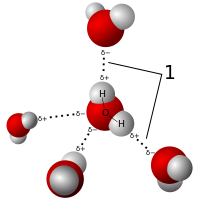
Photo from wikipedia
Polymorphic luminogens provide the opportunity to disclose relation between the packing patterns and performance of luminogen and facilitate design of high performance luminogens. However, the effect of intramolecular charge transfer… Click to show full abstract
Polymorphic luminogens provide the opportunity to disclose relation between the packing patterns and performance of luminogen and facilitate design of high performance luminogens. However, the effect of intramolecular charge transfer (ICT) is seldom used to construct luminogens with polymorphs, though the ICT process is very sensitive to microenvironment. In this work, 2‐(3‐(diphenylamino)‐9H‐xanthen‐9‐ylidene)‐malononitrile (DPAXM, 1) with donor–acceptor structure exhibits high contrast polymorphism dependent emission due to the effect of tiny differences of intermolecular interactions on ICT process. Three crystals of 1 with nearly identical structures emit yellow, orange, and red light with sequentially decreased efficiency which is attributed to ICT process modulated by the tiny differences in intermolecular interactions. In addition to ground state study, excited state of the polymorphs is investigated by time‐resolved ultrafast transient mid‐IR spectroscopy and theoretical calculation. Nonemissive crystals of 1 can also be obtained. The modulation of ICT effect by intermolecular interactions may provide a reference for the molecular design of high‐performance luminogens.
Journal Title: Advanced Optical Materials
Year Published: 2020
Link to full text (if available)
Share on Social Media: Sign Up to like & get
recommendations!